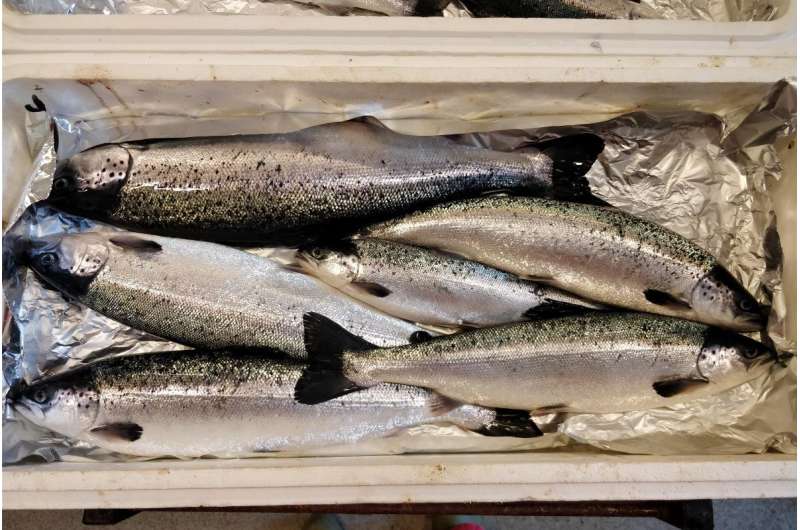Atlantic salmon eyes from varying genetic backgrounds (wild, farmed, hybrid), rearing conditions (artificial and natural) and life stages (parr, smolt, post smolt). Credit: Bangor University
The domestication of Atlantic salmon through years of fish farming has led to farmed Atlantic salmon developing smaller eyes according to a new piece of research published in the journal Evolutionary Applications.
Over 15 generations of breeding salmon in captivity for food, farmed fish have developed smaller eyes than wild salmon. This could have negative consequences for any farmed salmon who escape captivity as well as their offspring.
Smaller eyes could impact the salmon's eyesight, making them less able to identify and eat food, as well as increasing their chances of being eaten by predators.
The international team of researchers bred salmon from farmed, wild and hybrid (farmed x wild) backgrounds together from eggs in tanks at the Institute of Marine Research, Norway and the Marine Institute, Ireland, as well as in the Srahrevagh River, Ireland. Eye size was then measured in the freshwater and saltwater life stages of the salmon.
In all the tank-based experiments, both in Norway and Ireland, farmed fish had smaller eyes relative to body size when compared with their wild counterparts, with hybrids having an intermediate eyes size, even though they had been reared in the exact same conditions. Yet, intriguingly, when reared in the river, no differences in eye size were seen between wild and farmed salmon.
Farmed Atlantic salmon smolt. Credit: Bangor University
Genetic reduction in eye size seen in farmed fish
Dr. William Perry, a postdoctoral researcher working at Bangor University and co-lead of the research explained:
"It was exciting to discover this genetic reduction in eye size seen in farmed fish, but the fact it was not seen in salmon reared in the river was intriguing. We believe this is because the fish with the smaller eyes were less fit for a life in the wild and were unable to find food or escape the sharp bill of a heron! When in captivity, the salmon do not have to deal with these pressures."
What element of fish farming may have caused this reduction in eye size over 15 generations is not yet known, but it could be due to several factors. These could include how energetically expensive it is to grow eyes, and the fact that in captivity salmon do not need good eyesight to hunt or escape predators. Food appears automatically, and predators are kept out.
Alternatively, it could be a response to stress, or the artificial lights used in aquaculture. The fact that these animals are reared in tanks where they may experience unnaturally high levels of artificial light may mean that there is a benefit to smaller less light-sensitive eyes.
Dr. Joshka Kaufmann, a postdoctoral researcher at University College Cork, Ireland and co-lead of the research adds:
"We have been investigating the traits affected by hybridization between wild and farmed populations and how they can contribute to reduced survival. Showing what allows eye size to vary in the farm but not in the river gives us a clue as to why farmed fish and their descendants are ill-equipped to deal with life in the wild. Escapes from farms pose a threat to the genetic integrity of wild Atlantic Salmon populations and impact population abundance in the long-term."
More information: William Bernard Perry et al, Domestication‐induced reduction in eye size revealed in multiple common garden experiments: The case of Atlantic salmon ( Salmo salar L.), Evolutionary Applications (2021). DOI: 10.1111/eva.13297
Provided by Bangor University

























